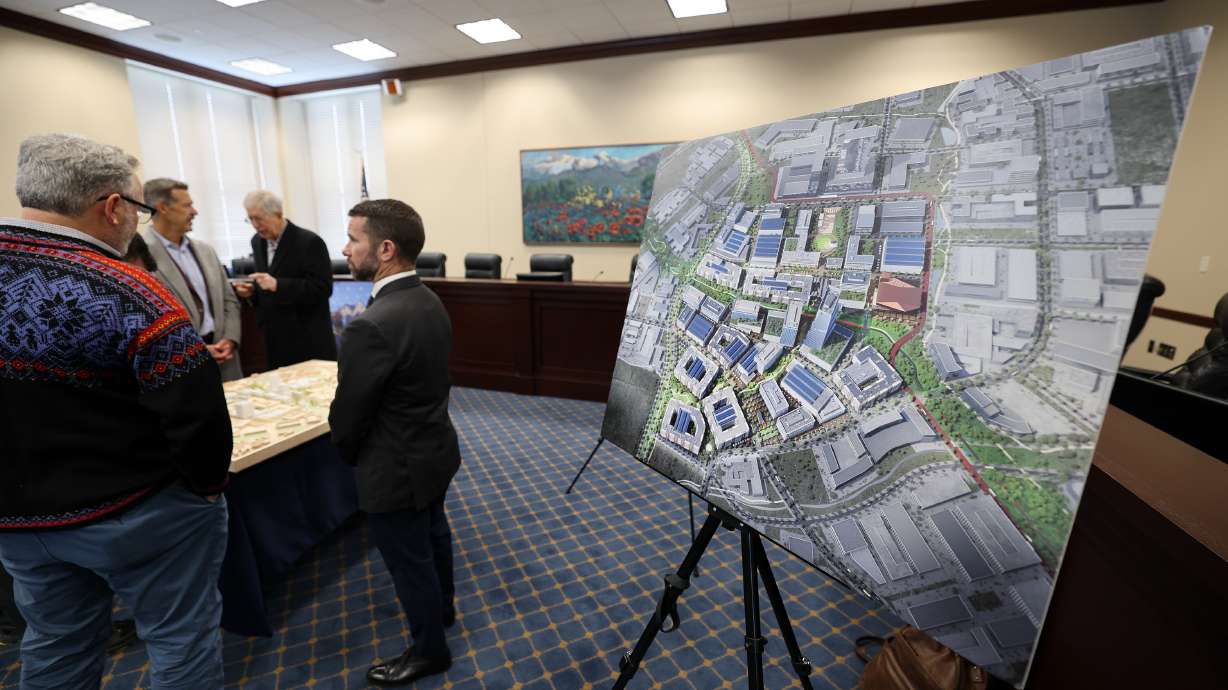Estimated read time: 4-5 minutes
This archived news story is available only for your personal, non-commercial use. Information in the story may be outdated or superseded by additional information. Reading or replaying the story in its archived form does not constitute a republication of the story.
DRAPER — The future of the old Utah State Prison site in Draper came into clearer focus Tuesday with the release of phase one development plans for a "15-minute" "walkable city."
The plans for the Point include over 3,000 housing units, 16 acres of parks, 220,000 square feet of retail space, 100% drought-tolerant landscaping and an entertainment venue that seats 3,000 people. Developers also plan to include five miles of trails and sidewalks, including a river-to-range trail and open space system that will connect the Jordan River Trail to the foothills of the Wasatch Mountains.
"We are not wasting any time building what Utahns want at the Point," said Alan Matheson, executive director. "The phase one development plans reflect robust public feedback and will catalyze future development for many years to come."
Developers envision the Point as a modern, walkable community, where people can live, work, learn and recreate all in one place. Sustainability and responsible water use will play key parts in the design.
Sustainability and walkability
Abbey Ehman, principal at Innovation Point Partners, said the company is tracking its carbon footprint throughout development and has a goal of using 30% renewable energies throughout the project. Once complete, she said, the community is expected to consume 30% less water, compared to baseline estimates; and the walkability will hopefully further reduce greenhouse gas emissions.
"The vision of a 15-minute city is that a two-car household could go to one because you can just rely on other modes of transit and walking to reach your destination — because all of your daily needs are within a 15-minute (walkable) radius," Ehman said. "People in Europe, they don't get in a car every day, and it's because the cities were built to support alternative ways of traversing. What this is going to do is make it so attractive that you don't feel like you have to rely on your vehicle to get through the site."
The Point promises that each of the housing units will be within two blocks of a park or trail, and the community will feature a main street called "the Promenade" that will cater to pedestrians and cyclists.

Ehman said developers plan to use water-wise landscaping to fill the green spaces at the Point, and will install low-flow water fixtures to cut back on use. All told, the reductions will save the equivalent of 250 Olympic swimming pools of water each year, compared with baseline conditions.
Sustainability efforts have been part of the plan from the beginning, Ehman said.
"We've thought through details to make sure that the goals of Utahns can be met, but that it's something that's financially feasible and represents market realities," she said.
'Intentional density'
Ehman said the Point has a unique opportunity to be a model for improved living along the Wasatch Front because it is situated between two growing population hubs in Salt Lake and Utah counties.
"Nowhere in the country does something like this exist," she said. "We can actually execute the development vision through the lens of building infrastructure the way it wants to be built."
That includes thousands of square feet of business and retail space, including an innovation district dubbed "Innovation Row," which hopes to attract corporate clients from Utah and elsewhere.
"Unlike other central business districts — or even downtown Salt Lake City — where the density has happened over time, here we can grow organically and future focused," Ehman said. "What we've proposed is even more dense than the original framework plan and the reason for that is because the quality of amenities within requires a certain density."
Of the 3,000 planned housing units, it's still unclear how many will be considered affordable housing, but Ehman said the Point is committed to diverse offerings of housing across the "spectrum of housing affordability."
"Part of the reason for the rise in home prices is because (Utah) is such a desirable place to be," she said. "So by having more residential units come online, we expect that that will help equalize what's been happening with residential home prices."

What's next?
After giving its initial approval to phase one on Tuesday, the Land Authority will refine development plans over the coming months. Construction on backbone infrastructure could begin as early as 2024, once demolition of the old Utah State Prison is complete.
Phase one covers development of just 100 of the 600 total acres at the Point. The remaining 500 acres will be developed in further phases.
Matheson said construction on buildings will start in late 2024 or early 2025, and he is optimistic that the first occupants will begin moving in in late 2026.
At a meeting at the state Capitol on Tuesday, Utah Rep. Lowry Snow — who is also the co-chairman of the Land Authority — thanked fellow lawmaker and outgoing Land Authority board member Steve Handy for his contributions to the development, including rebranding of the name the Point.
"I want to make sure that he gets credit and knows that we appreciate that because (the name) has stuck," Snow said.
"I'll feel great satisfaction going forward watching what the board is doing and what's happening at the Point," Handy said. "It's going to be a great thing for the state of Utah."









